Melons, encompassing a variety of sweet and succulent fruits, are a favorite in gardens worldwide. Among the most popular types are Honeydew and Cantaloupe, known scientifically as Cucumis melo. Growing melons from seed is one way gardeners can get sweet fruit from their land.
These melons belong to the Cucurbitaceae family, which also includes cucumbers, pumpkins, and squash.
Honeydew melons are recognized for their smooth, pale outer skin and sweet, green flesh, while Cantaloupes are known for their netted rind and vibrant orange, sweet flesh. Both types are warm-season crops, thriving in sunny conditions and well-draining soil.
These melons typically do well in USDA Hardiness Zones 4 through 11, with their growing season spanning the warmer months.
In cooler climates, they require a longer period of direct sunlight and warmth, often necessitating an early start indoors.
The key to successful melon cultivation lies in understanding their need for space, consistent warmth, and regular watering.
When to Start Melon Seeds

Timing is crucial for successfully growing melons, including Honeydew and Cantaloupe, especially considering the varying climates across different USDA Hardiness Zones.
In Zones 3-5
Begin sowing melon seeds indoors about 4-6 weeks before the last expected frost date. This early start is essential in these cooler climates to ensure that the plants have sufficient time to mature during the shorter growing season.
Once the threat of frost has passed and soil temperatures consistently reach above 70°F (21°C), seeds can be sown directly into the garden. This is typically late spring or early summer in these zones.
In Zones 6-8
In these zones, start seeds indoors about 3-4 weeks before the last frost date. This gives the plants a head start, allowing for an earlier and potentially longer harvest period.
Direct sow in the garden after all danger of frost has passed and soil temperatures are warm, usually in late spring.
In Zones 9-12
In warmer climates, starting seeds indoors can be beneficial if you want to manage the growth environment closely. Begin sowing 2-3 weeks before the last frost date.
Given the warmer conditions, seeds can be sown directly in the garden as early as late winter or early spring, after ensuring that the soil is sufficiently warm.
How to Start Melon Seeds
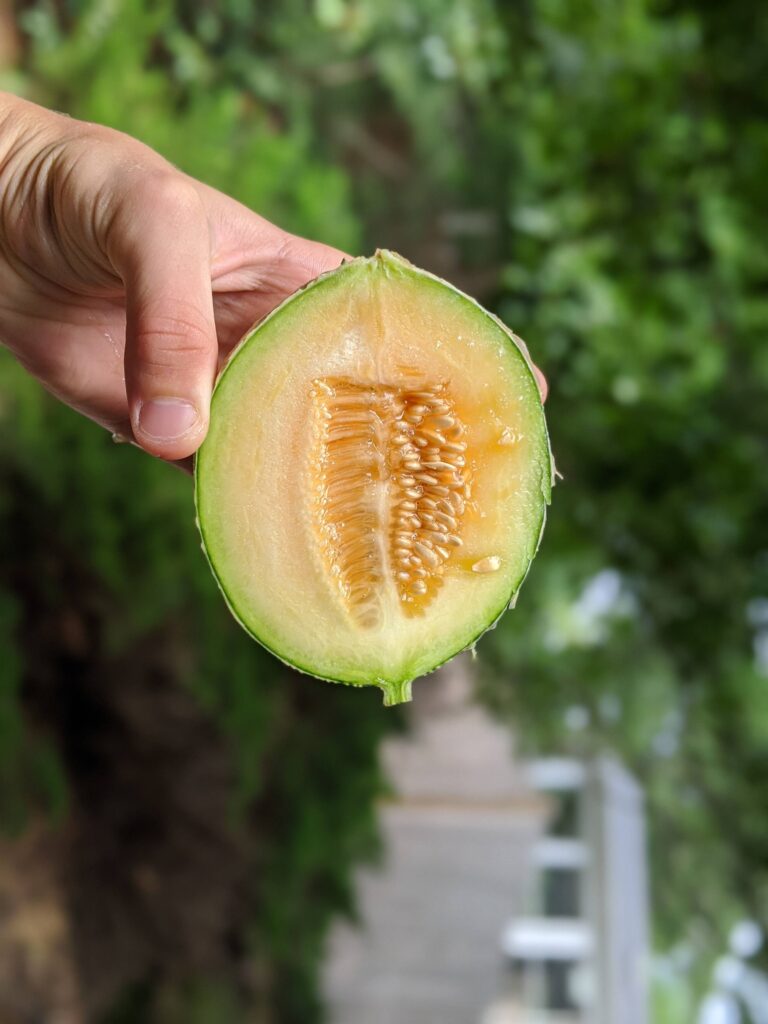
Starting melon seeds indoors can give your plants a head start, particularly in regions with shorter growing seasons. Here’s a step-by-step guide to get your melon plants off to a strong beginning:
Choosing or Making a Seed Starting Mix
Select a seed starting mix that is light and well-draining. A mix containing equal parts coconut coir, vermiculite, and perlite is ideal. This type of mix will retain enough moisture for seed germination while allowing excess water to drain, preventing root rot.
Choosing Containers for Starting Seeds
Use cell trays, small pots, or soil blocks for starting melon seeds. Containers should be at least 2-3 inches deep to accommodate the root growth. Ensure the containers have drainage holes to prevent waterlogging.
Depth to Plant
Plant melon seeds at a depth of about 1/2 inch. This depth allows the seeds to receive enough warmth and moisture for germination while being close enough to the soil surface to emerge easily.
Moisture Requirement for Seeds
Keep the soil consistently moist, but not soggy. Use a spray bottle to gently mist the soil surface, ensuring it stays damp but not waterlogged.
Optimal Temperature for Germination
Melon seeds germinate best at a temperature of around 75-85°F (24-29°C). Maintaining this temperature range is crucial, so consider using a heat mat under your seed trays if your growing area is cool.
Light Requirements for Germination
After planting, place the seed trays in a bright, sunny location or under grow lights. Melons need plenty of light to germinate properly and develop strong seedlings.
Time to Germination
Under ideal conditions, melon seeds typically germinate in 7-14 days. However, this can vary depending on the specific variety and environmental factors.
How to Prepare Garden Bed for Growing Melons
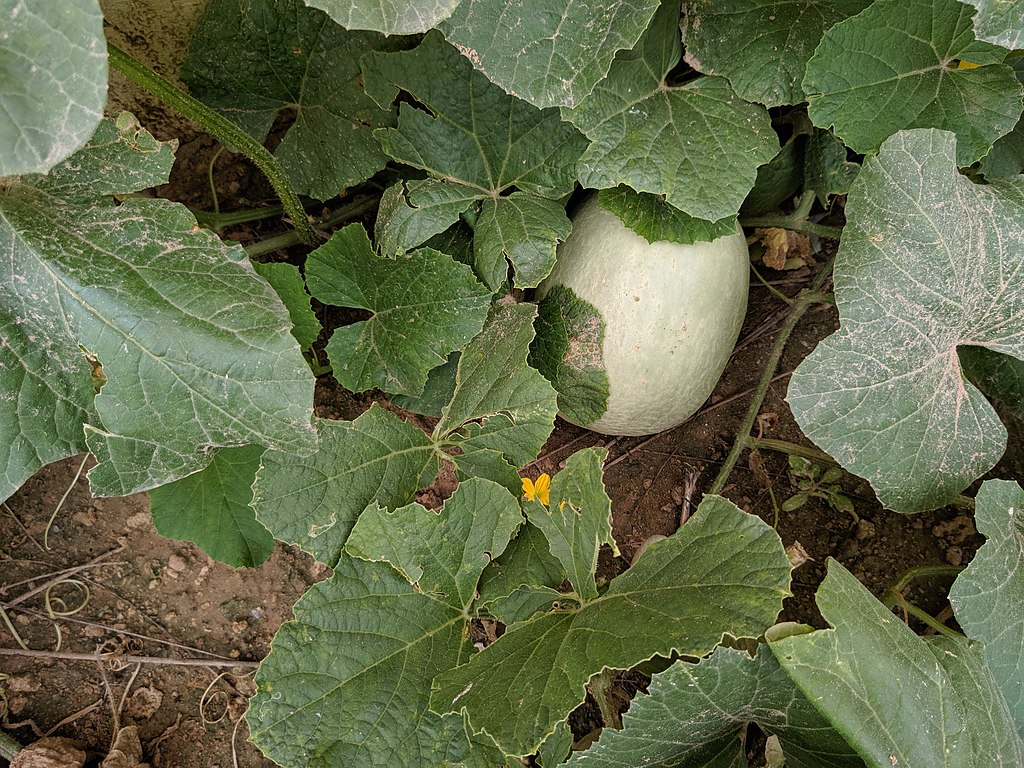
Preparing your garden bed for melons, such as Honeydew and Cantaloupe, using a no-dig or no-till approach is not only environmentally friendly but also beneficial for soil health. Here’s how to do it:
Choosing a Location
Melons thrive in full sun, requiring at least 6-8 hours of direct sunlight daily. Pick a spot in your garden that receives ample sunshine throughout the day.
While melons need regular watering, they don’t tolerate waterlogged soil. Choose a location with well-drained soil.
Melons prefer fertile, loamy soil rich in organic matter with a neutral pH. The presence of organic matter is essential for nutrient-rich, moisture-retentive, yet well-draining soil.
Preparing the Garden Bed
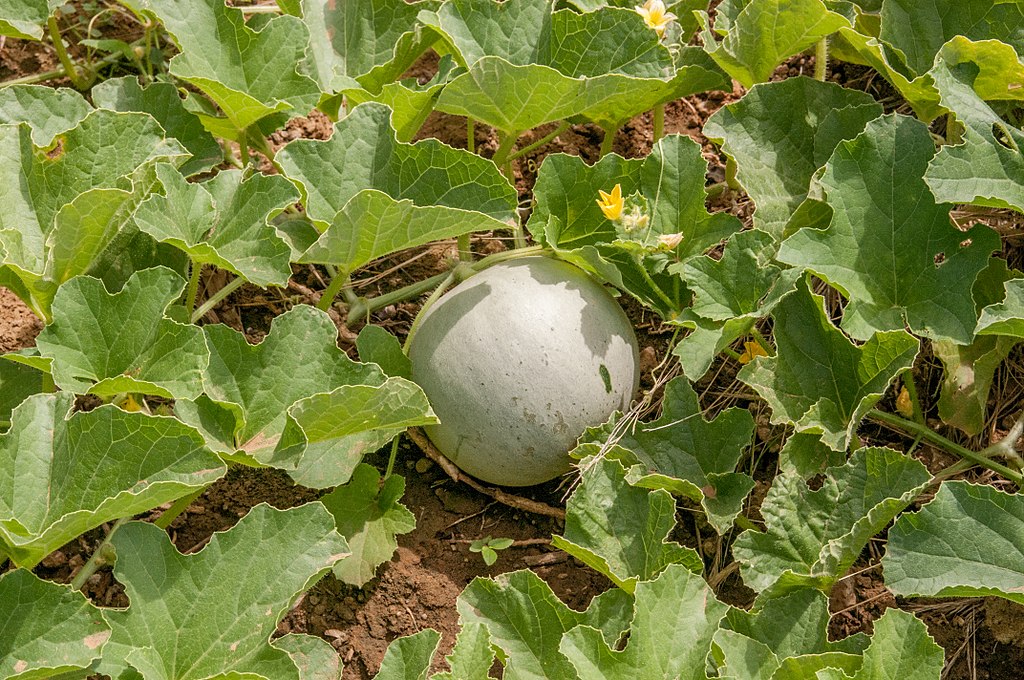
Start by laying a thick layer of organic matter over your garden bed. This can include compost, well-rotted manure, leaf mold, or a combination.
If the soil in your garden bed is compacted, you can gently loosen it with a garden fork.
Cover the organic matter with a layer of mulch, such as straw or wood chips. Mulch helps retain moisture, suppress weeds, and gradually breaks down, adding nutrients to the soil.
Allow the bed to settle for a few weeks before planting, if possible. This waiting period lets the organic matter start to integrate with the soil below and the microbial life to activate.
When you’re ready to plant, simply move aside the mulch and add a small amount of compost where you’ll place each seed or transplant. This minimizes soil disturbance.
Providing Support for Growing Melons from Seed
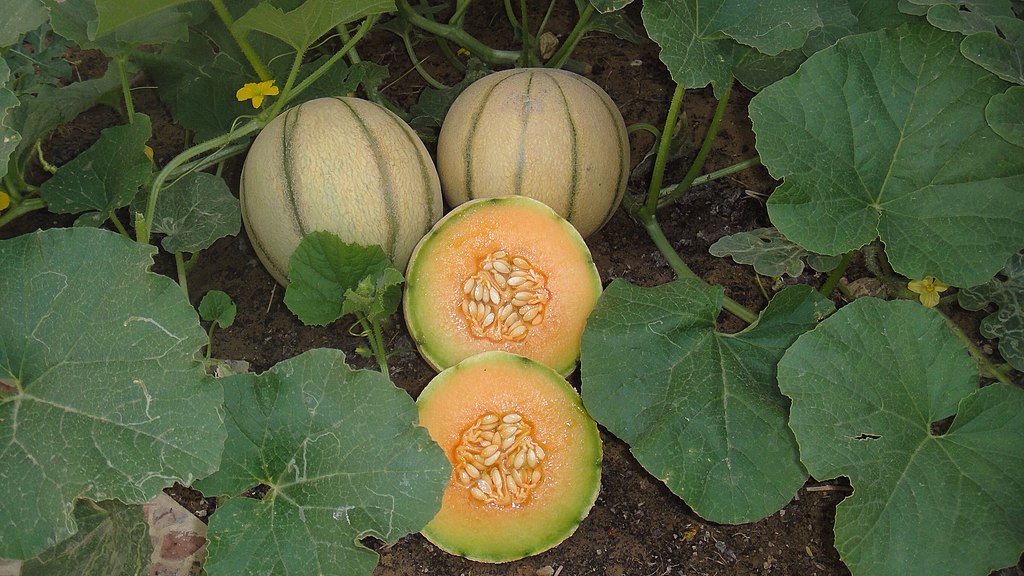
Melons, due to their vine nature and the weight of their fruit, often require support systems in the garden. Providing them with a trellis or other climbing structure helps to prevent disease and cut back on pest pressure.
Store-Bought Supports
Sturdy trellises and arbors are excellent for supporting melon vines. Look for ones that can handle the weight of mature melon fruits.
Garden netting or wire mesh can be used in conjunction with frames or stakes to create a support structure. Ensure the netting has large enough openings to handle melons as they grow.
DIY Support Ideas
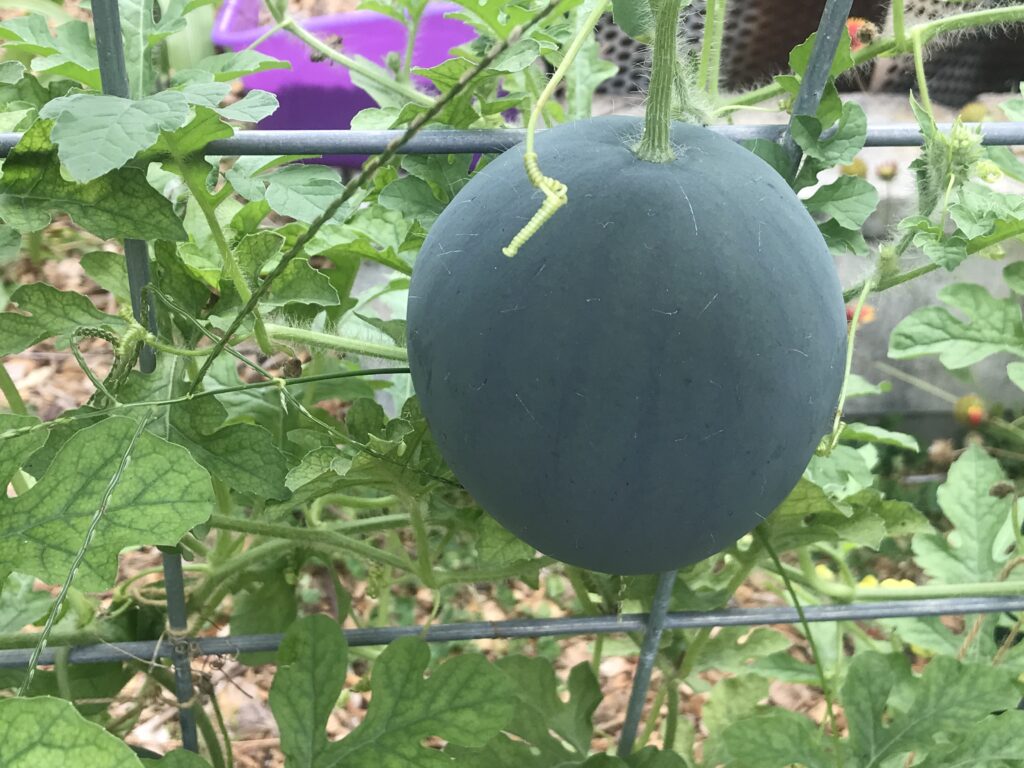
Build a wooden trellis using posts and horizontal slats. Ensure it’s anchored well into the ground and is strong enough to support the weight of the melons.
Or, create a frame using PVC pipes and attach garden netting or mesh to it. This lightweight structure is easy to move and can be customized to your garden size.
You can also construct an A-frame using wood or metal poles and stretch netting or strings across for the vines to climb.
When to Install Supports
Install the supports at the time of planting or just before the vines start to run. Early installation prevents damage to the developing root system and vines.
Place the support structure in a north-south direction for maximum sun exposure on both sides.
Make sure your supports are firmly anchored to withstand wind and the weight of the fruit.
Ensure there is enough space around the support for easy garden maintenance and harvesting.
Training Vines
As the melon plants grow, gently guide the vines onto the support structure. Use soft ties or strips of cloth to tie the vines to the support, if necessary.
Providing adequate support for melon plants not only helps manage space in your garden but also improves air circulation around the plants and can lead to healthier growth and easier harvesting.
How to Direct Sow Melons in the Garden
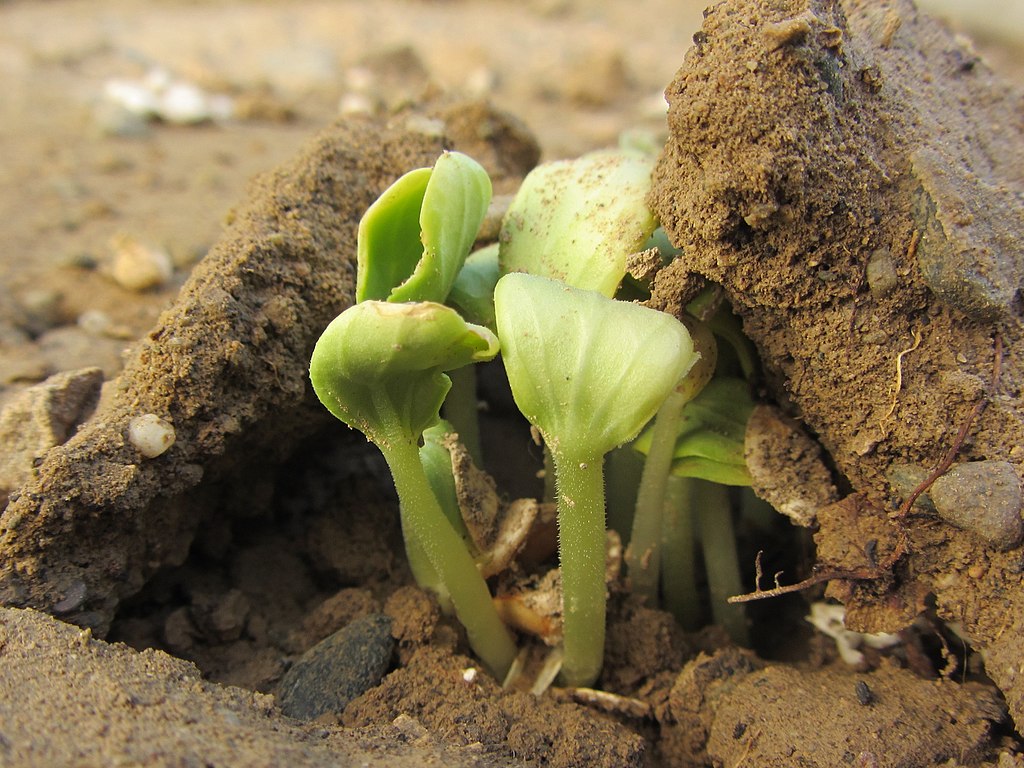
Direct sowing melons, including varieties like Honeydew and Cantaloupe, can be a rewarding experience if done correctly.
Direct sow melon seeds after the last frost date when the soil has warmed up to at least 70°F (21°C). This is typically in late spring or early summer, depending on your climate zone.
Plant melon seeds about 1/2 inch deep. You can sow 2-3 seeds per spot and space these spots about 24-36 inches apart. If planting in rows, keep the rows about 4-6 feet apart to provide ample space for vine growth.
Water the soil gently but thoroughly after planting the seeds. The goal is to moisten the soil without disturbing the seeds. Consistent moisture is crucial for germination.
Once the seedlings emerge and develop a few true leaves, thin them to keep the strongest seedling in each spot. This ensures that each plant has enough space and resources to grow.
After thinning, apply a light layer of organic mulch around the seedlings. Mulch helps retain soil moisture, suppress weeds, and maintain consistent soil temperature.
As the plants grow, gently guide the vines in the direction you want them to grow. This is especially important if you’re using a support structure.
Knowing When to Plant Out Melon Starts
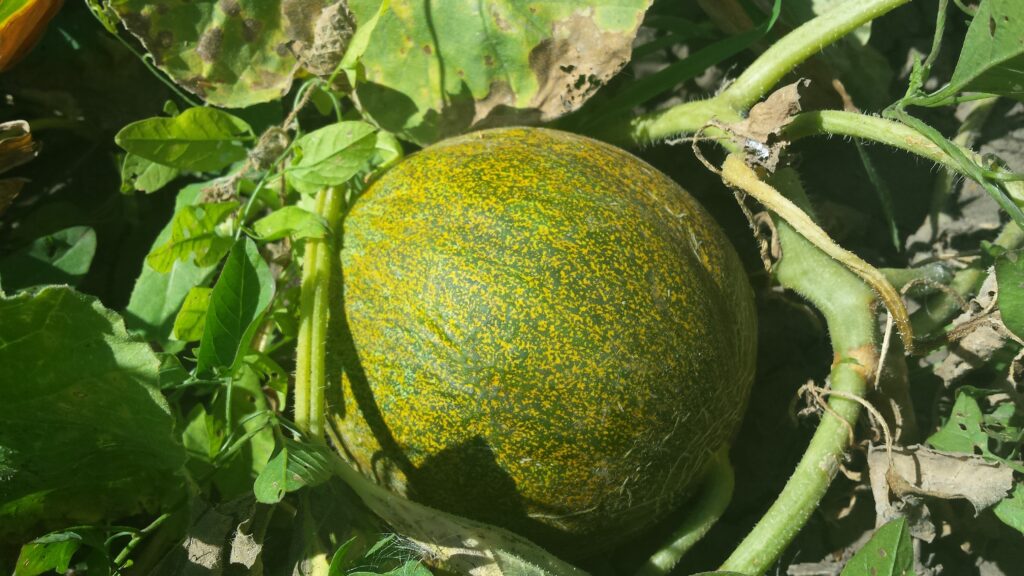
Determining the right time to transplant your melon starter plants, including varieties like Honeydew and Cantaloupe, is crucial for their successful transition to the garden. Here’s how to identify when they’re ready:
Typically, melon starter plants are ready to be transplanted when they’re about 3-4 inches tall and have at least two to three true leaves. True leaves are the leaves that emerge after the initial seed leaves (cotyledons).
Check the roots by gently removing a plant from its container. The roots should be well-developed, forming a small network, but not overly crowded in the container.
Hardening Off Melon Starter Plants
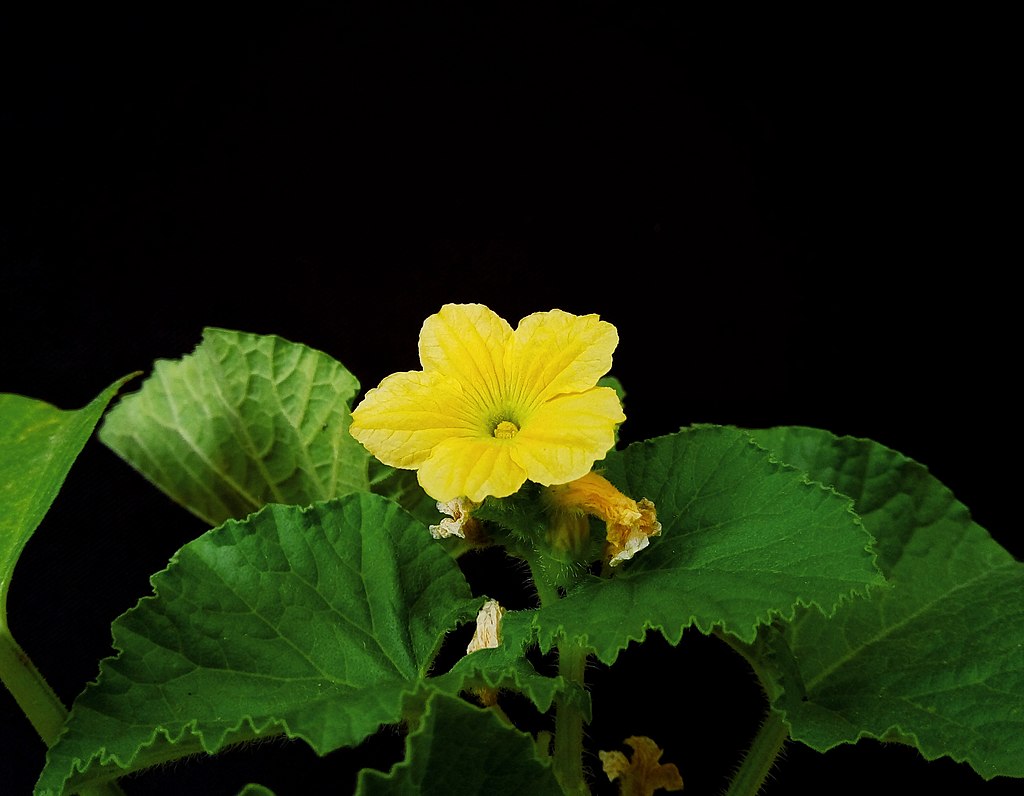
Hardening off is the process of gradually acclimating indoor-grown plants to outdoor conditions. Here’s how to harden off your melon starters:
About 7-10 days before you plan to transplant, begin exposing your melon plants to the outdoors. Start with 1-2 hours of outdoor time in a shaded, sheltered area.
Gradually increase the amount of time the plants spend outdoors each day. Also, slowly introduce them to more direct sunlight and varying outdoor temperatures.
Be mindful of extreme weather. Avoid putting young plants outside on overly windy days or when temperatures drop significantly.
Continue to water the plants as needed during the hardening-off process. Ensure they don’t dry out but also avoid overwatering.
By the last couple of days of hardening off, your melon plants should be able to withstand a full day and night outdoors, as long as temperatures don’t dip too low.
This gradual process prepares the plants for the shock of transplanting, reducing the risk of stress or damage when they are finally planted in the garden.
Planting Out Melon Starters
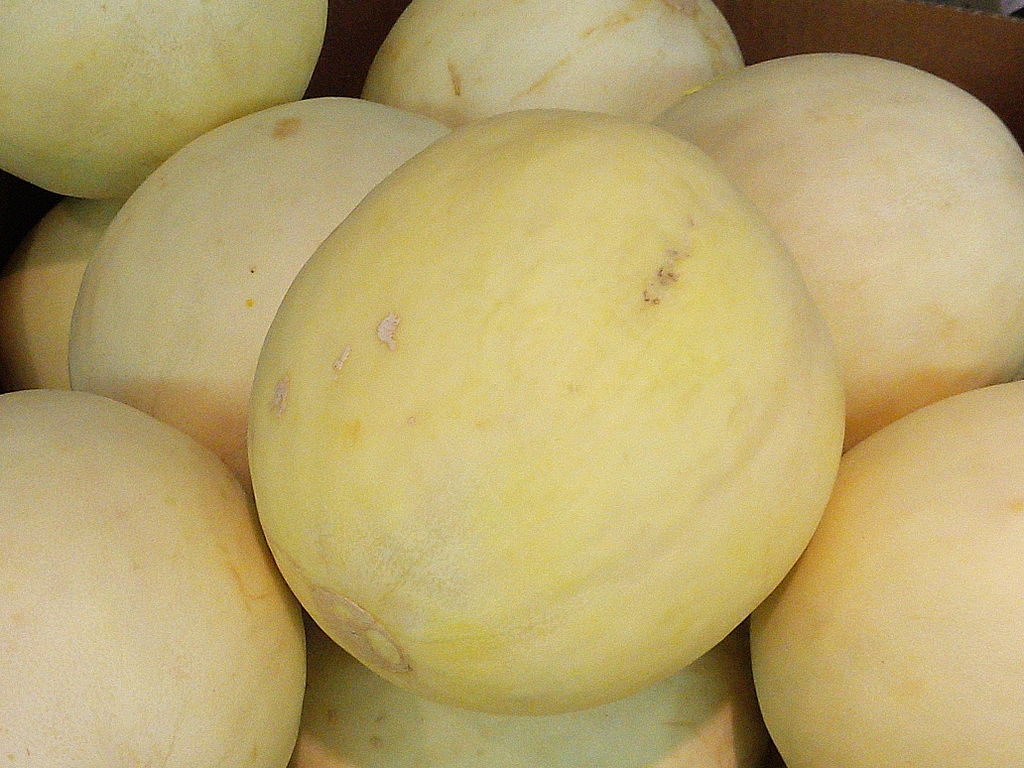
Transplanting your melon starters, such as Honeydew and Cantaloupe, into the garden is a critical step in their growth process. Here’s how to do it effectively:
Before planting, ensure your garden bed is ready. It should be well-drained, enriched with organic matter, and located in a sunny spot.
Plant the melon starters at the same depth they were growing in their containers. This helps prevent stem burying or exposure, which can stress the plants.
Space the plants about 24 to 36 inches apart. Proper spacing is crucial for adequate air circulation and growth room, especially as melon vines spread out.
After planting, apply a layer of organic mulch around the plants. Mulch helps retain soil moisture, keeps the roots cool, and suppresses weeds. Be careful not to pile mulch directly against the stems to avoid rot.
Water the plants thoroughly right after planting. This initial watering helps settle the soil around the roots and provides the moisture necessary for the plants to start establishing. Keep the soil consistently moist, especially during the early growth stages.
Trellising
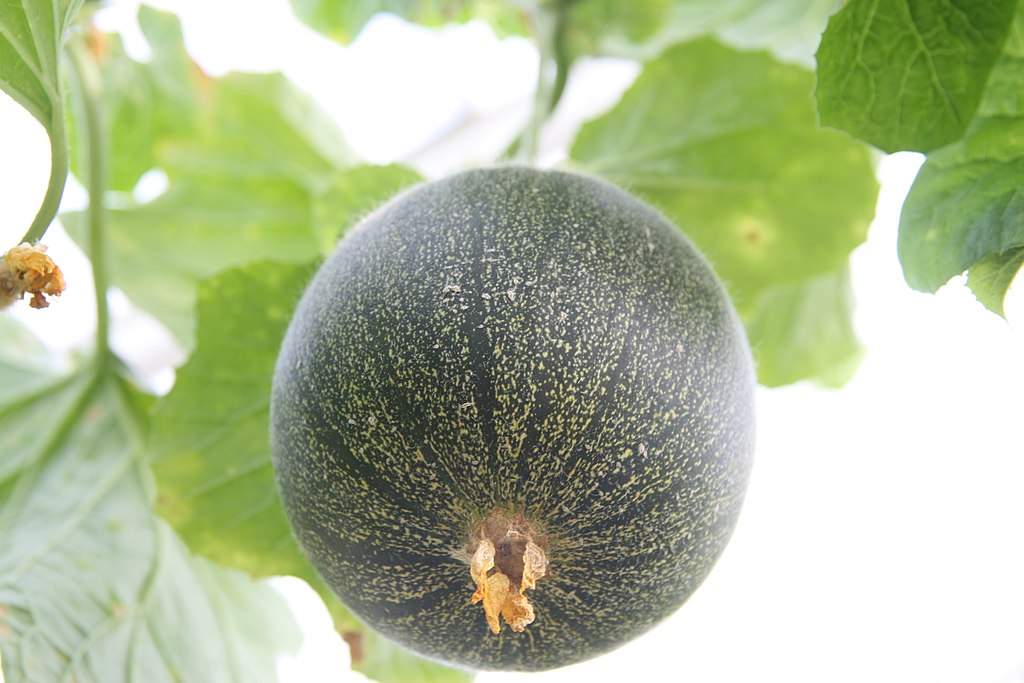
If you’re limited on space or prefer a tidier garden, consider using trellises for your melon plants. They really help prevent pest pressure and disease.
Install the trellis at planting time to avoid disturbing the roots later. Gently train the vines onto the trellis as they grow. This keeps the fruit off the ground, reducing the risk of rot and pest issues.
Caring for Melon Plants
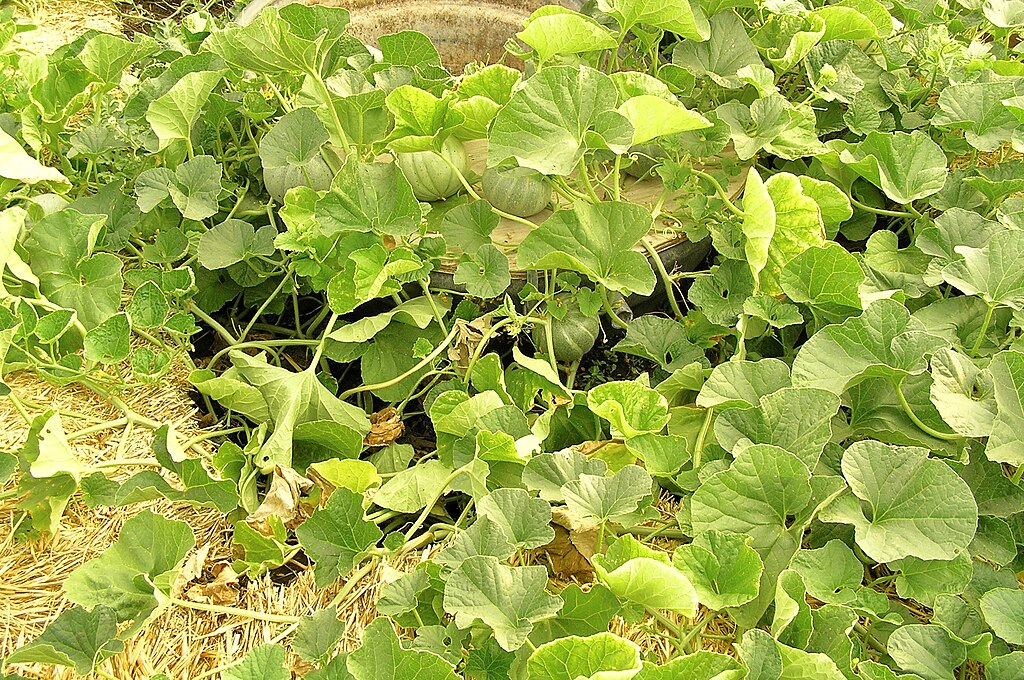
Melons require regular care to thrive and produce a bountiful harvest. Key aspects include proper watering, feeding, weed management, and support for the growing vines and fruits.
Watering
Consistency is Key: Melons need regular watering to ensure steady growth. The soil should be kept consistently moist, but not waterlogged.
Deep Watering
Water deeply to encourage deep root development. This is especially important during the fruiting stage.
Reduce Watering Near Harvest
As fruits mature, reduce watering to concentrate sugars in the fruit, enhancing flavor.
Feeding
Feed melon plants with a balanced fertilizer that is not too high in nitrogen, as this can encourage leaf growth at the expense of fruit.
Apply fertilizer after planting and again when the vines start to grow vigorously.
Once fruits have formed, consider a potassium-rich feed to enhance fruit development.
Weeding
Keep the area around your melon plants free from weeds. Weeds compete for nutrients and water, which can hinder plant growth.
Weed carefully to avoid disturbing the roots of the melon plants. Use hay or straw as a way to suppress weed growth to prevent damage.
Supporting and Tying Up
Use trellises to support the weight of the growing melons and keep them off the ground. This prevents rot and minimizes pest issues.
As fruits grow larger, support them with slings attached to the trellis to prevent them from falling off. You can use old stockings or net bags from grocery store produce.
Tips and Tricks for Growing Melons
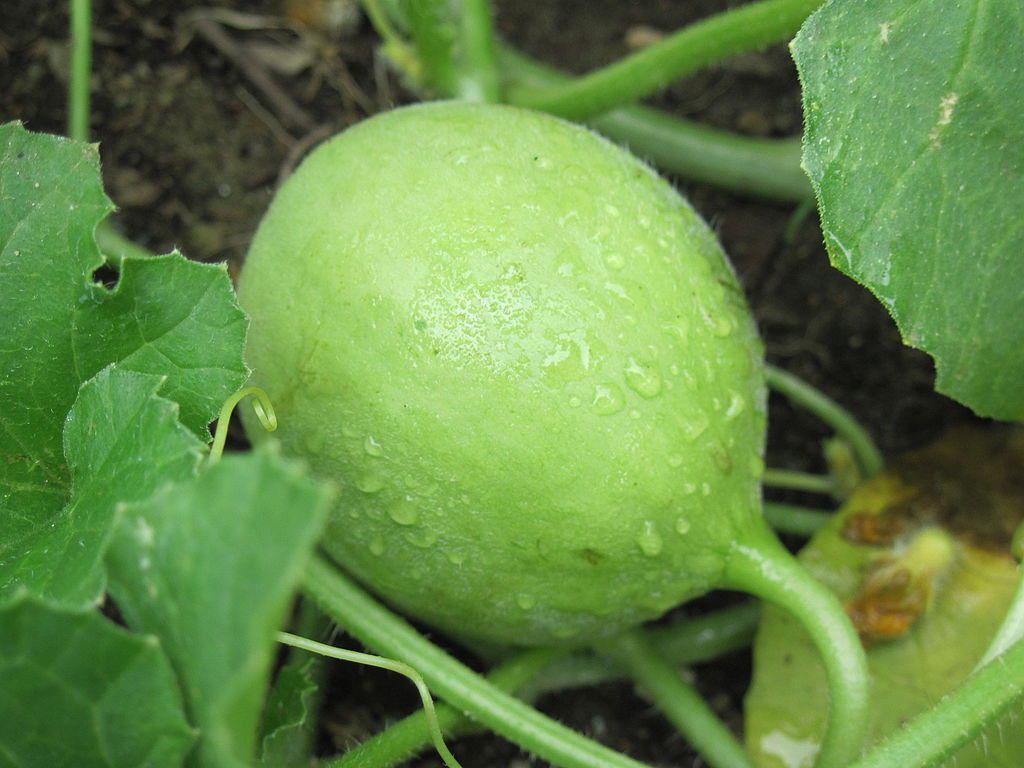
Growing melons like Honeydew and Cantaloupe successfully requires attention to a few key practices. Here are some tips and organic approaches to address common challenges:
General Growing Tips
Here are a few tricks we’ve picked up for growing melons from seed:
Warm Soil: Melons thrive in warm soil. Use black plastic mulch or fabric to warm the soil before planting.
Pollination: Ensure good pollination by attracting bees and other pollinators. Plant flowers like zinnias and cosmos nearby or avoid using pesticides that may harm these beneficial insects.
Harvest Timing: Melons are ready to harvest when they emit a sweet fragrance and the stem end yields slightly to pressure. The underside of the melon should also change to a yellowish color.
Organic Ways for Addressing Pests
Encourage beneficial insects like ladybugs and lacewings, which prey on common melon pests like aphids.
Use row covers to protect young plants from pests. Remove covers when plants start flowering to allow for pollination.
Insecticidal soaps or Spinosad can be effective against pests without harming the plant or beneficial insects.
Organic Ways for Avoiding and Treating Disease
Ensure proper spacing to improve air circulation, which can reduce the risk of fungal diseases.
Water at the base of the plants to avoid wetting the foliage, as moist leaves can be more susceptible to diseases.
Use organic fungicides like copper or sulfur-based sprays to manage fungal diseases. Apply as directed and in the early stages of disease development.
Additional Tricks
Gently rotate growing melons to ensure even sun exposure and prevent soft spots.
Enrich the soil with aged compost or manure to provide a steady supply of nutrients.
Use organic mulch to retain moisture, regulate soil temperature, and suppress weeds.
When to Harvest Melons
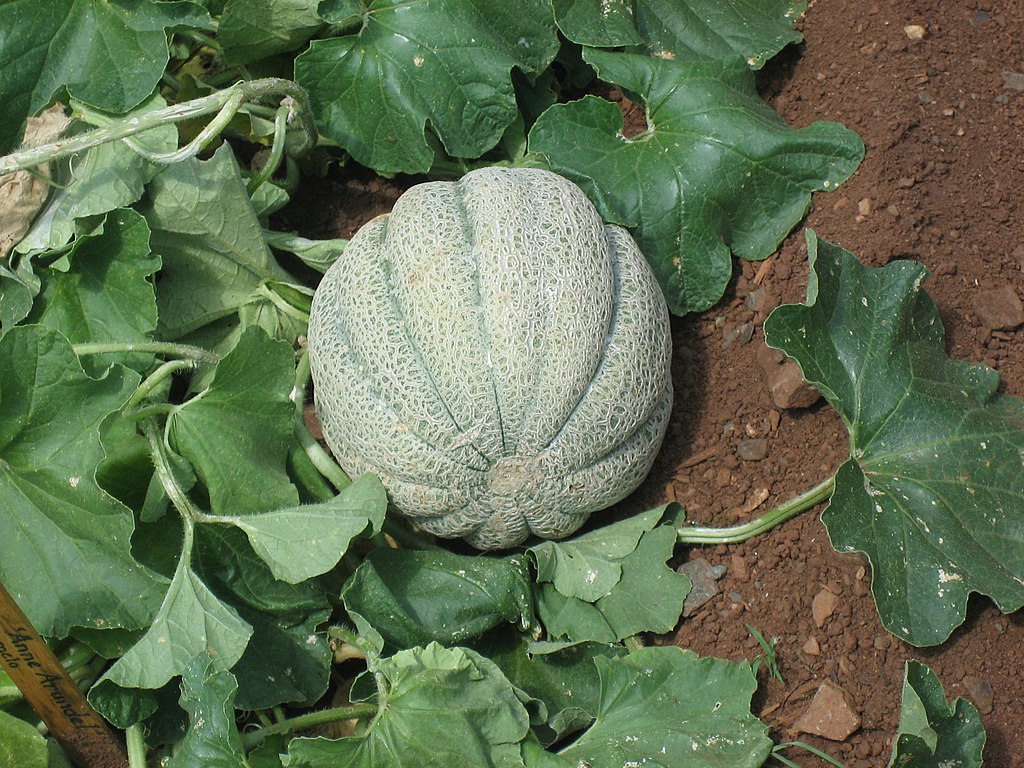
Understanding when muskmelons, like Honeydew and Cantaloupe, are ready to harvest is key to enjoying them at their best. Here’s what to expect:
Maturation Timeline
Muskmelons generally take about 70-100 days from planting to reach maturity, depending on the variety and growing conditions.
Signs of Ripeness
Look for changes in color and texture. Cantaloupes typically develop a more pronounced netting pattern and change from green to a yellowish background color.
Honeydews become slightly softer at the blossom end and may change in color, often to a lighter shade.
How and When to Harvest Muskmelons
The best indicator of ripeness is the ease of stem separation. When a muskmelon is ripe, it will detach easily from the vine with a gentle twist. This is known as the “slip” stage.
Ripe melons often emit a sweet fragrance at the blossom end.
Handle the melons gently when harvesting to prevent bruising or damage.
How to Store Melons
For best flavor, consume melons soon after harvesting. They can be kept at room temperature for a day or two.
To extend the shelf life, store ripe melons in the refrigerator. This can keep them fresh for about a week.
Whole, uncut melons should be kept in a cool, dry place away from direct sunlight. Once cut, wrap the melon in plastic and refrigerate.
Melons can be frozen, although this may alter their texture. Cut the melon into cubes or balls and freeze in a single layer before transferring to airtight containers or freezer bags.
Growing melons from seed, including delightful varieties like Honeydew and Cantaloupe, is a rewarding endeavor for any gardener.
Remember, patience and attention to detail are key. With the right care, you can turn a few small seeds into an abundance of flavorful melons that are a testament to the joys of gardening.
